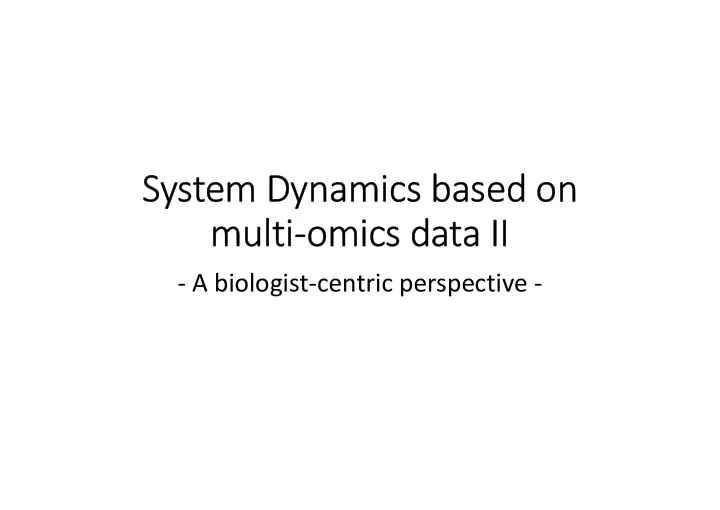

System Dynamics based on multi-omics data II - A biologist-centric perspective -
Outline • What a biologist hopes to get… • What a biologist typically gets… • Where a biologist gets stuck… • How a biologist is trying to overcome limitations…
Sysbio in a nutshell OMICS PHENOTYPE Genes, RNAs, Morphology in vivo in vivo Proteins & PTMs, Physiology Metabolites Fitness Lipids Pathology in vitro “classical reductionistic Top-down: Bottom-up: techniques” „Find components & „Find the simplest model(s) interactions from data!“ to predict system’s behavior!“ Biological insights (components, interactions, kinetic laws, parameters,…)
Typical biologist’s question: What’s going on? translation: What causes the phenotype?
A thought experiment Ein Gedankenexperiment Typical biologist’s question: What causes the phenotype? Let’s assume you can measure ALL RNAs|proteins|metabolites in a cell… how do you address the question?
Task #1: what caused this fingerprint? red = higher in mutant, green = lower in mutant, size = p-value
Task #2: what caused this scenario? red = higher in mutant, green = lower in mutant, size = p-value
Example: Response of skin cells to H2O2 after 5 min 20 min 60 min Q: Which enzyme(s) cause the observed metabolic patterns?
Is multi-omics the solution?
My very personal take after 10 years SysBio (and > 500’000 analyses) It’s simple to find differences Biological events ‘omics changes It’s difficult to unravel the causes
Fundamental challenges Human intuition doesn’t scale. It’s hard to measure the right thing, i.e. activity and interactions.
We can measure components efficiently, but what about the rest? Biological insights (components, interactions) Data mining Prediction
What about measuring activity? Sauer, Heinemann & Zamboni, Science 2007
Open questions • How to map interactions in vivo? • How to identify the interactions that determine a given phenotype? • How do we predict phenotypes for novel conditions/perturbations?
How do we generate testable hypotheses from omics profiles? 1. Include network information in data mining Different levels of sophistication: - Graph (directed or not) - Thermodynamics, kinetics - Prior information on regulatory links - … 2. Use time-resolved experiments - Time imposes a hierarchy on events - Time allows to resolve fast from slow events 3. Reference metabolomics sets
Reference datasets Systematic ‘omics analysis upon known perturbations - E. coli single gene knockout library (35’000, completed) - Druggable genome siRNA library (32’000, in progress) - Yeast TFs, kinases, proteases (> 2000, completed) - 200 (cancer) cell lines (1500, completed) - Drugs (…) Non-targeted reannotation of ORFs - E. coli proteome (>22’000 , completed) - Yeast proteome (>35’000 , completed) - Human proteome (...
Example: Metabolic segmentation by Random Markov Fields Q: Which enzyme(s) likely caused the observed metabolic patterns? G6PDH GAPDH
Time in cellular processes DNA mRNA Proteins Metabolites seconds minutes hours days Time scale Resolve translational responses from Characterize temporal organization direct effects, e.g. during metabolic transients • • allosteric regulation of metabolites Adaptation • on enzymes Development • • Kinome, PTMs Cell cycle • • xenobiotics (drugs) Circadian rythm
7.47 7.4 7.33 7.27 7.2 7.13 7.07 7 6.93 M 6.87 6.8 6.73 6.67 6.6 6.53 6.47 6.4 6.33 6.27 6.2 6.13 6.07 Transcriptional responses 6 5.93 S 5.87 5.8 5.73 5.67 5.6 5.53 5.47 5.4 5.33 5.27 5.2 5.13 5.07 Differentiation 5 4.93 4.87 4.8 Adaptation 4.73 4.67 4.6 G1 Cell cycle 4.53 4.47 4.4 4.33 Hours 4.27 4.2 4.13 4.07 4 3.93 3.87 … 3.8 3.73 3.67 3.6 3.53 3.47 3.4 3.33 M 3.27 3.2 3.13 3.07 3 2.93 2.87 2.8 2.73 2.67 S 2.6 2.53 2.47 2.4 2.33 2.27 2.2 2.13 2.07 2 1.93 1.87 1.8 1.73 1.67 1.6 1.53 1.47 1.4 G1 1.33 1.27 1.2 1.13 1.07 1 0.93 0.87 Real-time metabolomics 0.8 0.73 0.67 0.6 0.53 0.47 0.4 0.33 0.27 M 150 Discover small molecule – enzyme Determine reaction mechanisms PEP (on-target and off-target) hexose-6-P Investigate in vivo drug and kinetic parameters 100 interactions metabolism Seconds pyruvate 50 glucose 0 5.5 5 4.5 4 3.5 3 2.5 2
Ensemble (mass) modeling allows to identify key regulatory interactions Metabolite Fold-changes Küpfer et al, Nature Biotech 2007 > SIGNALING Link et al, Nature Biotech 2013 > ENZYME – METABOLITE INTERACTIONS Link et al, Nature Methods 2015 > ALLOSTERIC REGULATION Link et al, Curr Opin Biotechnol, 2014
Ensemble modeling for analysis of cell signaling dynamics Küpfer et al, Nature Biotech 2007
Example II: In vivo discovery or allosteric regulation Several key enzymes in glycolysis are known to be potentially activate/inhibited by metabolites. Q: In condition XYZ, which allosteric links are actively regulating glycolysis? Link et al, Nature Biotech 2013, 31(4):357
Test for all network topologies that can mimick metabolite dynamics • ODE model of metabolism and putative allosteric links • Perform time-resolved metabolomic experiment • Ensemble modeling Test which models can reproduce the data. In this case, 3’600 variants with 0-2 allosteric interactions exist. • Count how frequently an interaction leads to a good fit • Biochemical assay in vitro Link et al, Nature Biotech 2013, 31(4):357
Recap Challenges : • How to generate testable hypotheses from omics data? (OMICS > targeted, ad-hoc assays) • How to map interactions in vivo? • How to identify the key interactions that determine a given phenotype? • How do we predict phenotypes for novel conditions/perturbations? It’s a combined computational/analytical effort.
Recommend
More recommend